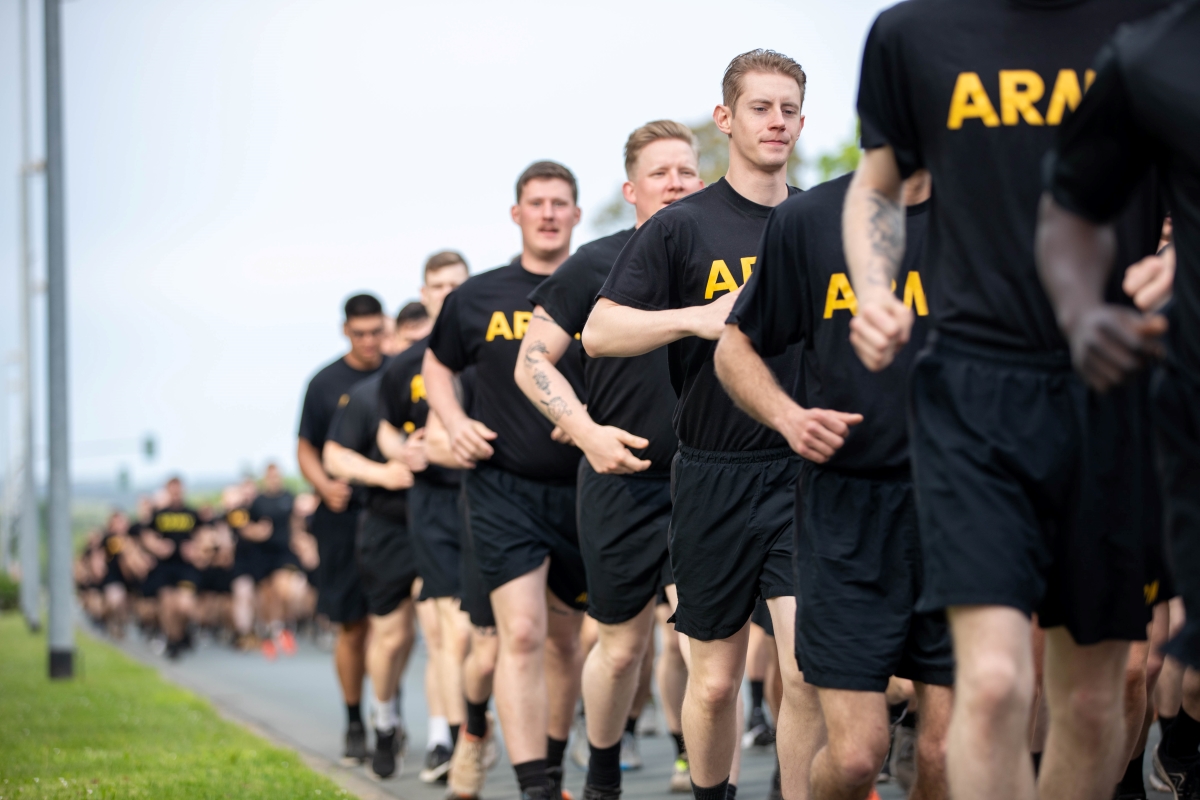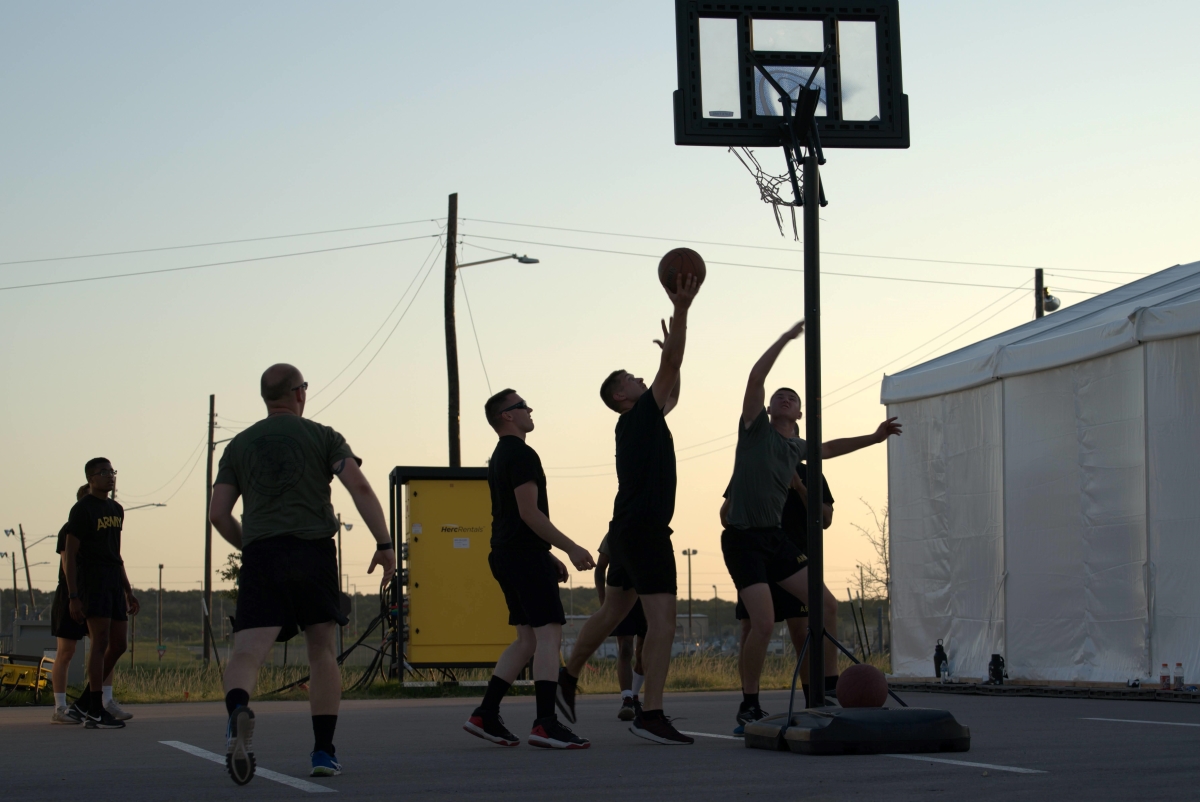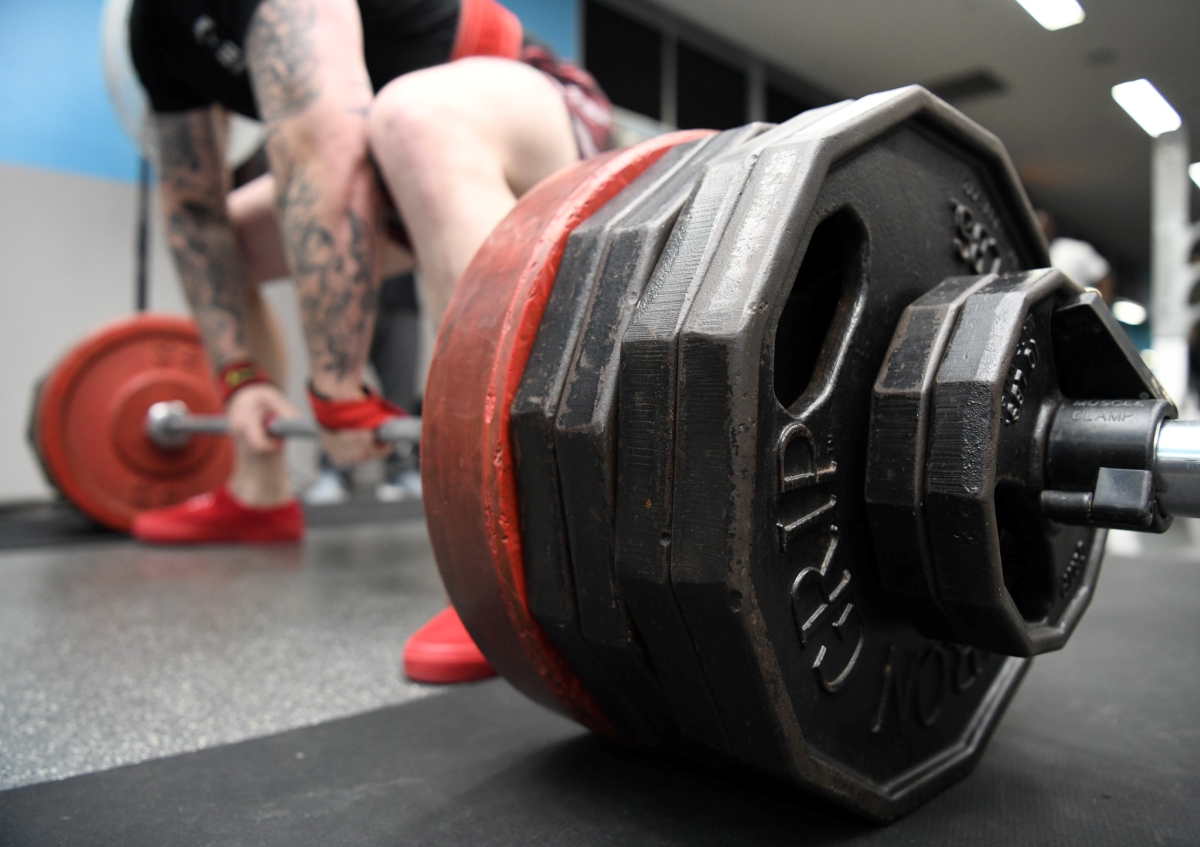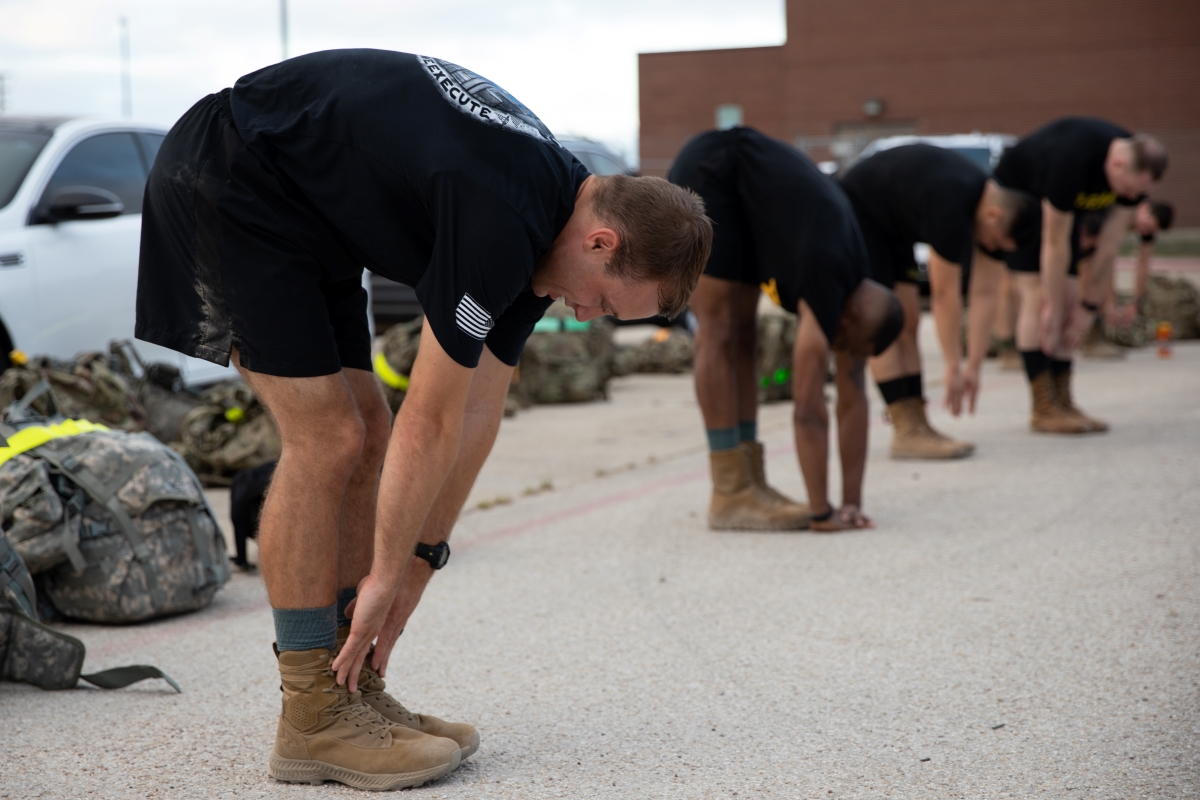- Aerobic Exercise (Running-related) Injuries
- Eye Injuries
- High Intensity Training and Extreme Conditioning Programs
- Physical Training Programs
- Team Sports (Basketball, Football, Softball)
- Weight Training
- Winter Sports
- Unique Prevention Tools and Assessments
Aerobic Exercise (Running-related) Injuries

Running is one of the most popular forms of cardiovascular (aerobic) exercise but has also been found to be one of the most common causes of injuries in military populations. This is because while running is an excellent form of exercise, the repetitive stresses to the body can damage tissues. Injuries include
musculoskeletal (MSK) injuries such as joint pain, tendonitis, sprains, strains, and stress fractures to the lower extremities (knee, lower leg, ankle, foot).
Most running-related injuries are preventable as they are associated with "overtraining" or “overuse” (i.e. with increasing distances too quickly or running distances too often).
Prevention: Contrary to some beliefs, science has not identified specific running form(s) or shoe types that will reduce most running injuries. Instead:
- Ensure a proper gradual increase to run distances
- Moderate overall running distance and frequency with alternate forms of aerobic activity to improve cardiovascular health (e.g., swimming, cycling, rowing, aerobic equipment, brisk walking).
- Balance running and aerobic workouts with muscle strengthening and agility activities.
- Manage your weight through proper eating and a variety of exercises for 150 to 300 minutes of aerobic and two strength building activities a week. Per the
CDC
 :
:
- A minimum goal of 150 minutes a week could be achieved 30 minutes a day for 5 days a week, or 22 minutes daily, or different durations for 3 days totaling 150.
- Some people may need to be more active than others to reach or maintain a healthy weight.
Technical references
Eye Injuries
"Sports" are a
common reported ‘cause’ of eye injuries in Service members. This is consistent with
common traumatic eye injuries reported in the civilian sector .
.
Getting hit or poked in the eye by fingers, hands and elbows is a common sports injury. Getting hit by balls, racquets or other sports equipment also occurs. Sports that have highest eye injury risk are those involving high velocity objects (i.e., baseball, softball, hockey, racquet sports) or person-to-person contact especially without headgear (i.e., basketball, soccer, touch-football).
Prevention: Proper sports goggles/impact-resistant eyewear is the key to prevention.
- Wear proper eye protection especially during basketball, football, hockey, racquet sports, soccer and skiing.
- Evidence has found that the use of inappropriate eye wear (e.g., non-shatterproof eyewear or sun protection glasses) can actually increase the risk of severe eye injury.
- While the military has a program to ensure
approved eyewear for military activities, various forms of approved shatterproof goggles are recommended for different sports (see Table 4).
 Ask your eye doctor for recommendations.
Ask your eye doctor for recommendations.
High Intensity Training and Extreme Conditioning Programs (ECP)
Exercise programs that include multiple high-intensity aerobic and muscle strengthening activities have become quite popular. While specific studies of ECPs are still limited, common injuries such as shoulder and back have been noted due to the weight-lifting components of these programs.
Prevention: Although the military has not specifically endorsed specific ECPs, exercise regimens that include a proper balance of aerobic and muscle strengthening activities are at the core of the military's physical fitness training and testing. Prevention strategies include:
- Use of certified trainers
- Gradual increase of weights, repetitions, and speed
- Rest days
Technical references
Physical Training Programs
An over-emphasis on running has been one of the biggest problems with many exercise programs, especially in some military units. Excessive running can mean running distances that are too long, running too often, increasing distances too rapidly especially for newer runners, or not allowing adequate rest and periodization for individuals with existing injuries and/or other physical conditions.
Prevention: To reduce chance of injuries associated with your physical training program ensure that you:
- Balance running with other forms of aerobic activities (such as cycling or swimming) and anaerobic exercise including muscle strengthening and agility activities
- Gradually increase duration and intensity of any new activity (e.g., running, specific weight-lifting exercise) or when recovering from injury
- Include adequate rest periods by alternating types of activities on different days, and ensuring adequate rest time when injured
Additional information:
Technical references
Team Sports (Basketball, Football, Softball)

In addition to eye injuries described above, sports are the cause of many acute injuries to Service members. Past data has found:
- BASKETBALL: Past data identified basketball one of the leading sports to cause injuries to Army Soldiers – including during deployment, where basketball injuries have contributed to many medical evacuations. Basketball mishaps cause fractures, sprains, strains, eye and orofacial injuries.
Prevention: - Ankle and wrist braces may reduce some musculoskeletal injuries.
- As described above, shatterproof eye protection can reduce risk of eye injuries.
- Mouthguards can reduce risk of orofacial and dental injuries; read our
Mouthguard Factsheet. The use of a rigid ankle brace could reduce rates of ankle injuries, a leading type of basketball injury.
Technical references
-
FOOTBALL: Acute injuries associated with football can be prevented with equipment.
Prevention: Mouthguards and helmets can reduce risk of injuries.
Technical references
- SOFTBALL: Acute injuries associated with softball can be prevented with equipment.
Prevention: The use of break-away bases in softball can reduce risk of injuries, as can mouthguards and batting helmets.
Technical references
Weight Training

Weight training (WT) has increased in popularity especially as it is recognized that a balanced exercise regimen should include muscle strengthening activities. Muscle strengthening or "resistance training" exercises include use of free weights, weight machines, elastic bands, medicine balls and plyometrics to increase muscle strength, as well as muscle endurance, and/or power. WT is a type of resistance training that relies on free weights and weight machines and various controlled explosive movements to increase strength and power. Common WT exercises include the
deadlift,
squat, and
bench press. Military data identified that using the bench press exercise is a risk factor for certain arm and shoulder injuries especially
pectoralis ruptures.
Recommendations for WT exercises to increase strength/power reflect American College of Sports Medicine guidance for healthy adults:
- 2-3 times per week for each major muscle group
-
>48 hours between sessions
- Weights: 60-70% of maximum repeated lift capability (1RM) for novice to intermediate; 80% 1RM for experienced lifters
- 8-12 repetitions; 2 sets, no more than 4 sets
- 2-3 minutes of rest between sets
Prevention: To minimize risk of WT injury,
- Use proper trainers to ensure good form
– this is critical
- Gradually increase the amount of weights
- Don't overdo the number of repetitions
- Take adequate rest breaks during a session and days between sessions
Winter Sports
Evidence shows that winter sports result in hundreds of thousands of acute trauma injuries as well as many deaths in the U.S.
each year
that winter sports result in hundreds of thousands of acute trauma injuries as well as many deaths in the U.S.
each year . Injuries include fractures, sprains and traumatic brain injuries (TBI). Past study of fall-related injuries among Active Duty service members has indicated that snowboarding and skiing, including when these activities are during military-unit organized events, are the leading sports causing such injuries. Injuries also occur during ice skating, hockey, and snowmobiling.
. Injuries include fractures, sprains and traumatic brain injuries (TBI). Past study of fall-related injuries among Active Duty service members has indicated that snowboarding and skiing, including when these activities are during military-unit organized events, are the leading sports causing such injuries. Injuries also occur during ice skating, hockey, and snowmobiling.
Most common winter sports injuries appear to be 'mild' TBIs, also known as
concussions . According to the Department of Defense TBI Center for Excellence
. According to the Department of Defense TBI Center for Excellence , concussions make up more than 80% of all TBIs in the military population. Only about 8% of these are combat-related. Most service members who sustain a mild TBI return to full duty within 10 to 14 days through rest and a progressive return to activity process where individuals gradually return to normal activity using a standardized, staged-approach. During this time, they may need assistance adjusting to various physical, mental and emotional health consequences of their injuries.
, concussions make up more than 80% of all TBIs in the military population. Only about 8% of these are combat-related. Most service members who sustain a mild TBI return to full duty within 10 to 14 days through rest and a progressive return to activity process where individuals gradually return to normal activity using a standardized, staged-approach. During this time, they may need assistance adjusting to various physical, mental and emotional health consequences of their injuries.
Prevention: Use of sports-specific approved safety equipment, such as helmets, shatterproof eye goggles, braces or padding (ankles, wrists, knees) can reduce injuries.
- Wear a properly fitted helmet that is certified for the sport you are going to enjoy – the CDC provides tips for selecting the best helmet
 .
.
- Wear other appropriate clothing/equipment such as goggles and boots, and check that equipment works before each use (test your board or ski bindings, ensure proper fit for skiing and skating boots).
- Know your level of experience and:
- Seek proper training or certifications before taking on more difficult challenges.
- Practice more complicated techniques under safe conditions.
- Familiarize yourself with surroundings before skiing or snowboarding, and:
- Know the terrain and any obstacles to avoid.
- Use official designated trails and sports areas as opposed to 'backyard' private lands.
- Start slow and easy at new locations until terrain is familiar.
- Be wary of poor trail design or unknown, unmaintained areas.
- Be aware that even some maintained slopes or trails may have "black spots," areas known for conditions that have resulted in repeated or high numbers of injuries - merging slopes, narrowing or sharp-turning trail and poor grooming.
- Condition your body and do exercises to increase your lower body stability control:
- When new to a sport, at the start of a season, or before new techniques or equipment.
- Examples include squats and lunges for lower body strength; stability balls and wobble boards for balance; and shuttle drills for side-to-side agility.
- Slowly progress in level of intensity and time and ensure rest breaks.
-
Always have a phone or radio with you to contact help when you're on trails while snowboarding or skiing. In the event that you hit your head or get hit in the head, it is important to have it checked out right away.
Technical references
Unique Prevention Tools and Assessments
Blister Prevention
Physical training and sports can result in potentially serious injuries from blisters. Read our Blister Prevention Factsheet or Army.mil article to minimize the severity and frequency of these injuries.
to minimize the severity and frequency of these injuries.
Technical references
Mouthguards
Mouthguards are required for many sports as a proven means to reduce the risk of serious orofacial and dental injuries. Read our Mouthguard Factsheet to help identify the best mouthguard to reduce these injuries.
Technical references
Stretching – does it help prevent injuries?
Current science as to when, how much, what type of stretching might reduce injury is still inconclusive. This is because the limited studies available have evaluated stretching differently – including different types of stretching (such as static, dynamic, ballistic, plyometric), types of exercise, durations, outcomes, and populations. the American College of Sports Medicine recommends 2-3 days a week of flexibility stretching This includes certain kinds of stretches and flexibility exercises that will increase the range of motion (ROM) of a muscle or muscle group and improve performance.
However, stretching immediately prior to exercise has not been proven as a means to reduce risk of injury, and may even increase risk of certain injuries (e.g., a muscle strain). In addition, in a study of a cohort of military personnel, the persons most flexible and those least flexible had higher injury rates than those with moderate flexibility.
The current ASCM recommendation is:
- 5-10 minutes of light to moderate cardiovascular warm up before stretching.
- After exercising, some gentle stretching may help reduce soreness, but this depends on the type of stretching and exercise. Alternatively – gentle cardiovascular cool downs may also serve this purpose. See section below on "Warming Up and Cooling Down."
Technical references
Warming Up and Cooling Down
Done properly, beginning workouts with a warm-up and ending with a cool-down can improve performance as well as reduce later soreness and possibly reduce risk of certain types of injuries.
Current Physical Activity Guidelines (page 62) recommend warming up with a lower intensity cardiovascular exercise (e.g., walking, jogging or biking), then transition to a few minutes of low intensity focus on any unique muscles or movements more specific to the exercise activity (e.g., dribbling a ball in soccer, lifting lighter weights).
(page 62) recommend warming up with a lower intensity cardiovascular exercise (e.g., walking, jogging or biking), then transition to a few minutes of low intensity focus on any unique muscles or movements more specific to the exercise activity (e.g., dribbling a ball in soccer, lifting lighter weights).
For specific warm-up drills, see FM-22 Holistic Health and Fitness (page 6-5). Stretching and flexibility exercises are also important aspects of an exercise program as they can increase range of motion (ROM) and thus may enhance performance or reduce soreness, but should be done only after initial cardiovascular warm-ups or during the cool down phase of workout.
(page 6-5). Stretching and flexibility exercises are also important aspects of an exercise program as they can increase range of motion (ROM) and thus may enhance performance or reduce soreness, but should be done only after initial cardiovascular warm-ups or during the cool down phase of workout.
Technical references
Rehabilitation and Recovery
The Human Performance Resource Optimization Center supports overall military human performance optimization as a DoD the educational arm of the Consortium for Health and Military Performance (CHAMP) at the Uniformed Services University of the Health Sciences (USUHS). One of the topics it provides information on is the RX3: Rehab, Refit, Return to Duty
supports overall military human performance optimization as a DoD the educational arm of the Consortium for Health and Military Performance (CHAMP) at the Uniformed Services University of the Health Sciences (USUHS). One of the topics it provides information on is the RX3: Rehab, Refit, Return to Duty program. The RX3 program was developed by two sports medicine doctors and an exercise physiologist and is a resource for both providers and service members for basic injury prevention and rehabilitation methods, including includes videos and printable material. Additional source: TB MED 592 Prevention and Control of Musculoskeletal Injuries Associated with Physical Training.
program. The RX3 program was developed by two sports medicine doctors and an exercise physiologist and is a resource for both providers and service members for basic injury prevention and rehabilitation methods, including includes videos and printable material. Additional source: TB MED 592 Prevention and Control of Musculoskeletal Injuries Associated with Physical Training.
Technical references
